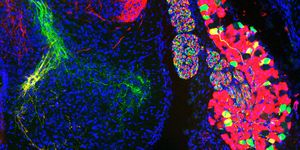Using AI to Build a Better Immunotherapy
T cells that are used in immunotherapy have to be programmed to efficiently destroy cancer cells. Researchers have now used artificial intelligence (AI), instead of experimentation in the laboratory, to create a library of about 2,300 "command sentences" that can be used to direct engineered T cells to kill cancer. Those commands can be tailored so that clinicians and researchers can create the optimal T cells to fight specific diseases. The work has been reported in Science.
Receptors on the surfaces of cells can bind to molecules in their environment, allowing them to sense certain conditions or detect other cells or molecules. When cells are engineered to be therapeutic, researchers typically select or develop receptors that are added to the surfaces of cells, so those cells can complete a novel task. For example, chimeric antigen receptors (CARs) can be added to T cells that are removed from a patient so the modified cells can be given back to the patient, where they will seek and destroy cancer cells. But that process doesn't work for all types of cancer.
Cell surface receptors also have a portion that hangs out inside the cell, sometimes called a motif. Those motifs, alone or in concert, can direct functions inside the cell based on binding that occurs outside the cell.
Many CAR T cells will actively kill cancer for a time, then they pause for awhile. That pause can allow cancer time to regrow. In this study, the researchers wanted to create a CAR T cell that wouldn't pause its activity. Totally new cellular commands were created using machine learning that rearranged various motifs. Hundreds were tested in T cells. The researchers were able to develop new CAR T cells that could operate continuously.
The motifs were acting like words in totally new sentences that were instructing the engineered cells to carry out certain tasks more efficiently.
"We changed some of the words of the sentence and gave it a new meaning. We predictively designed T cells that killed cancer without taking a break because the new sentence told them, 'Knock those rogue tumor cells out, and keep at it,'" explained first study author Kyle Daniels, Ph.D, a researcher in the lab of Professor Wendell Lim, Ph.D., director of the UCSF Cell Design Institute.
"This is a vital shift for the field," said Lim, who is senior study author. "Only by having that power of prediction can we get to a place where we can rapidly design new cellular therapies that carry out the desired activities."
Sources: University of California, San Francisco (UCSF), Science









